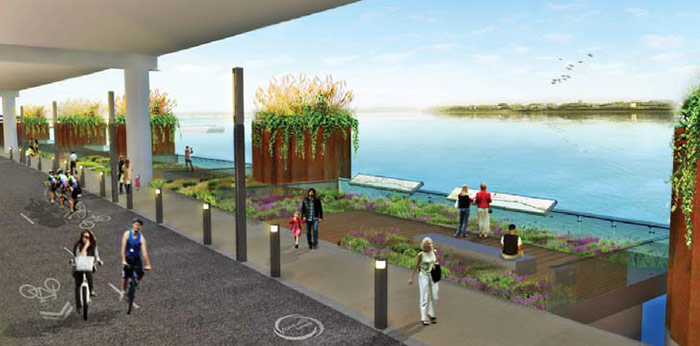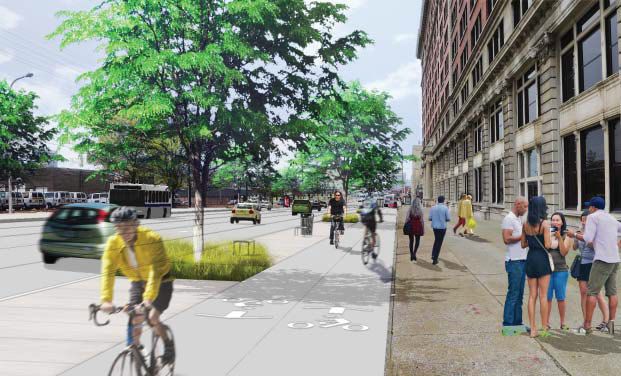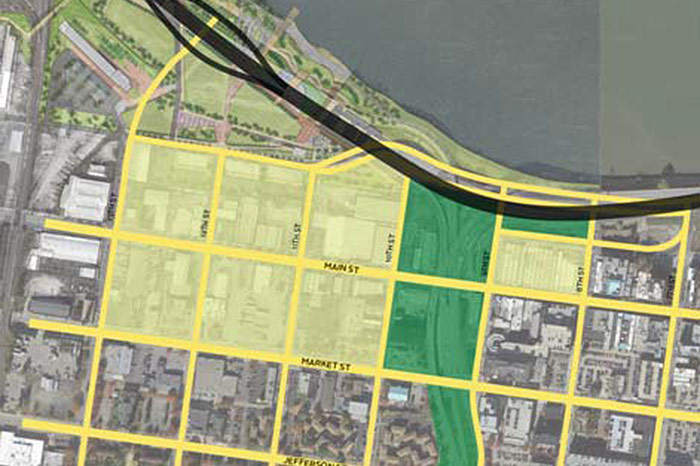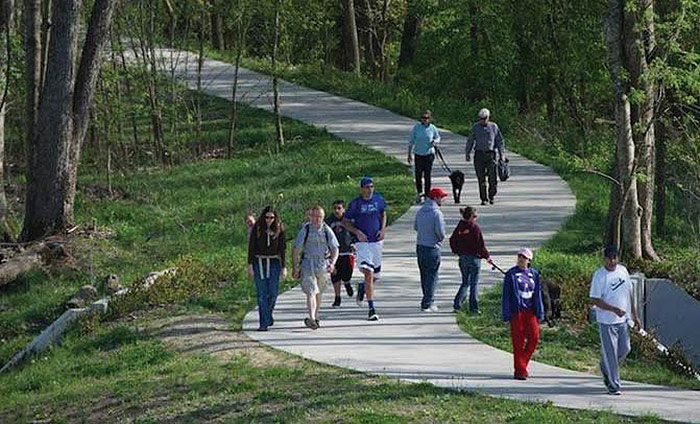After a couple of extensions, the official public comment period for the draft Move Louisville plan ends on Tuesday, July 5. Move Louisville will help guide transportation policy and the projects that will change the face of our city for the next two decades. It’s crucial that we get the official plan right. And we urge you to get involved—we already did.
To submit a public comment to Move Louisville, simply visit Metro Louisville’s website here.

Broken Sidewalk, Bicycling for Louisville, and the University of Louisville Sustainability Council sat down with the city’s Move Louisville team to get additional details about the document and we submitted a joint comment to the city highlighting the many good elements of the plan and a few changes we’d like to see implemented.
Below is our comment in full. Hopefully it will offer some inspiration to you in writing your own note to Metro Louisville.
Dear Move Louisville Team:
On behalf of Broken Sidewalk, the University of Louisville Sustainability Council, and Bicycling for Louisville, thank you for taking the time to meet with us in May to discuss the Move Louisville plan. We appreciated the chance to sit down with you and go over both the plan’s goals and the proposed projects that will serve as strategies for implementing those goals. Thank you as well for all the time and energy you put into creating this plan, which will steer transportation priorities in Louisville for decades to come.

Move Louisville’s goals are exactly what we would hope for in a plan aimed at creating a less car-dependent, more multimodal city. As you note in your report, there is a lot to be gained for our city in moving in this direction: improved health for our citizens, better air quality, a more sustainable built environment, and greater connectivity (p. 6). In the planning process, your team considered many projects that could help us achieve these goals. And ultimately, you chose 16 priority projects that scored highly across seven criteria: (i) promoting economic growth, (ii) providing choice for citizens, (iii) enhancing neighborhoods, (iv) improving safety and health, (v) ensuring environmental sustainability, (vi) maintaining fiscal responsibility, and (vii) assuring equity for all users (p. 7).
We can hardly argue with any of these goals. And Louisville’s ability to implement projects that meet this criteria will be vital to building our city’s future as a happy, vibrant, and healthy place to live for all residents.
It is critical that each priority project actively advance the goals of the Move Louisville plan. While we support the stated goals, we have concerns about the projects chosen to achieve them—and how they fit (or do not fit) your outlined criteria. Many of the projects are great, but a few appear to be contradictory to the goals of the plan, and others should be enhanced or shifted to more effectively move us toward meeting the plan’s goals.
The Good and The Bad


To start, we’d like to make clear that we believe many, in fact most, of the priority projects listed in the Move Louisville plan will be fantastic additions to the city when implemented.
Urban complete street projects (Broadway / Baxter Ave, Lexington Road, Ninth Street) will enhance neighborhoods, promote sustainable growth, and vastly improve mode choice. Transforming Dixie Highway into a premium transit corridor promises to promote connectivity and safety.

Expanding River Road into West Louisville and making it into a calmer, more accessible road in East Louisville will open up Waterfront Park and its surrounding neighborhoods. And two-way conversions in Downtown will be a great benefit, both in safety and economic development, to our central business district and core neighborhoods. These proposed projects should be pursued immediately.

However, there are a few priority projects included in Move Louisville that give us pause. The report makes clear that Louisville currently is, even by the modest standards of modern U.S. cities, sprawling, unhealthy, and car-dominated (p. 31). It is therefore troubling that some of Move Louisville’s proposed projects would further entrench this status quo.

For instance, two of the plan’s four “Regional Economic Development Projects” (Urton Lane and East Louisville Connectivity) would undoubtedly promote sprawl and auto-dependency, not diminish it. In your East Louisville Connectivity synopsis, you note, “It is anticipated that many of the larger projects will be focused on Interstate improvements” (p. 73). How does that meet any of the plan’s goals? These projects should be removed from Move Louisville so as not to establish precedents that undermine the plan’s efficacy moving forward.

Likewise, the Louisville Loop project meets none of the plan’s goals and should be removed. It is an expensive, time-consuming project that encourages suburban development, while delivering little in terms of economic growth opportunities, connectivity, sustainability, or neighborhood enhancement. It is purely a recreational enhancement which has no place in a transportation plan. In its place, we encourage extending the Beargrass Creek Trail to the Butchertown Greenway, which would connect Downtown into the inner East End neighborhoods and Cherokee Park.
Good to Great: Enhancing Existing Projects

Our strongest recommendations come as suggestions to take some of the proposed projects further. Many of the 16 priority projects should be enhanced in order to maximize their benefits to the community. For instance, the Main Street / Story Avenue intersection redesign is a fantastic idea that would meet many of the plan’s goals. It should definitely be pursued. However, we would like to see this project expanded to include many of the other intersections on the edges of Nulu and Phoenix Hill—Baxter and Jefferson, Baxter and Liberty, and Liberty and Chestnut. A more ambitious plan to make all of those intersections people-friendly would go a long way toward unlocking the walkability of Nulu and connecting it to Butchertown, the Highlands, and Phoenix Hill, thereby enhancing all four neighborhoods.
Similarly, walkability in Downtown is a problem. And while the Move Louisville document acknowledges this, it does little to offer solutions beyond suggesting two-way street conversions. This project, too, needs to be enhanced: Downtown is Louisville’s most important neighborhood because it’s the one we all share. The curb extensions at intersections on West Main Street have been an excellent addition to Museum Row. They should be expanded to Jefferson Street, Market Street, and the rest of Main Street, from Ninth Street to Baxter Avenue. And for transit, premium corridors should be established on Main / Market for east-west connectivity and on Second / Third for north-south connectivity. As you note, these routes are already two of our most traveled (p. 40–41).

The project most in need of a shift in focus is the suggestion to turn Preston Highway into a complete street and premium transit corridor. If we are to maximize limited resources and capital, the Preston corridor is the wrong choice for these changes. A more viable alternative to Preston would be the Goss Avenue / Logan Street / Shelby Street corridor through Germantown, Schnitzelburg, Shelby Park, and Smoketown. Goss is already thriving with investment, development, and density. For the same reasons that Baxter / Bardstown is a good choice as a corridor, Goss would be too. And Logan and Shelby streets would be transformed by a two-way, complete streets redesign, extending the energy of Germantown north through Shelby Park and Smoketown.
As for Preston Highway, it certainly should not be left in its current condition. While it is not dense enough to sustain a premium transit corridor, reconfiguration of the intersections around Eastern Parkway would be a boon for walkability, calming traffic, and improving economic opportunity for local business.
Conclusion


It is our opinion that although the Move Louisville plan points to vitally important goals for our city, it does not lay out a comprehensive enough strategy for achieving them. While there is certainly merit in many of the outlined priority projects, the projects described in the plan will, unfortunately, be insufficient to the task of reshaping Louisville around these common goals. What is needed is a progressive, ambitious plan that can help us reprioritize the way our city grows.
Louisville is faced with hard choices about where and how to prioritize investments, and, as currently constructed, the Move Louisville plan dithers on making those choices. The plan promotes a number of projects that are either contradictory to the goals of Move Louisville or too modest to achieve them. In essence, it is a plan that would do little to disrupt the status quo in developing our city. Today, we have an unsustainable system built on suburban sprawl, deferred maintenance, and car-dependency. Continuing this pattern will only make these problems worse and hinder Louisville’s ability to compete with cities that address these issues more aggressively.
Louisville deserves a transportation plan with projects and policies that will truly prioritize dense urban development and increase the safety and quality of life of all residents regardless of mode choice. We urge you to amend the Move Louisville plan’s priorities to more directly consider how we can achieve these goals.
Sincerely,
Branden Klayko, Broken Sidewalk
Justin Mog, University of Louisville Sustainability Council
Chris Glasser, Bicycling for Louisville
Submit your own comment to Move Louisville here before July 5.



I would really like to see Louisville invest in a light rail system. Follow the highways: Crestwood to Downtown; Preston Highway to Downtown; One line following 264 around. We should also be focusing on walk ability and biking within the city. We should also focus on zoning changes etc that would allow for easy development of mixed use properties (perhaps even require new developments to be mixed use in certain areas).
I wonder if our railroads will every see a dearth of traffic if autonomous trucks replace them and the rails eventually find themselves empty and freed up to passenger traffic. It seems like a lot of them used to be for passengers and it would be great to see them like that again.